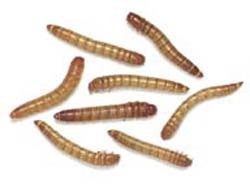Feed Suet All Year Long
Suet is a high-energy, pure-fat substance that supplements birds’ daily diet year-round and is particularly helpful when finding insects to eat is difficult. All of our suets and no-melt suets contain high-quality ingredients, providing critical fats and calories and making every trip to the feeder count. Also, WBU suet is rendered to help remove some of the impurities that can cause spoilage.
Suet allows you to feed the birds year round. Offer Suet when temperatures are below 80ºF and No-melt Suet Dough when seasonal temperatures are above 80º F. No-Melt Suet Dough is designed to withstand temperatures up to 130° F.
Offering suet at a backyard feeding station is one way to attract a greater diversity of insect-eating birds. Birds that eat suet will still find natural food sources, such as insects, insect eggs and larvae for a well-rounded diet. Birds that eat both insects and seeds, like chickadees and nuthatches, will also visit suet feeders.
 Mealworms Are For The Birds!
Mealworms Are For The Birds!
Mealworms are a great way to attract birds that don’t ordinarily come to seed feeders. Many birds eat insects naturally, so feeding mealworms to the birds is a natural thing to do. Many local birds are potential consumers of mealworms, including phoebes, bluebirds, orioles, robins, wrens, all the warblers (among our most colorful birds), towhees, gnatcatchers, chickadees, bluejays, nuthatches and more.
Mealworms are the larvae of the beetle Tenebrio molitor (the Flour beetle, a member of the Darkling beetle complex). They are a very high source of protein for the birds. To maintain the larvae in a state of dormancy, they should be refrigerated at 40 to 50 degrees Fahrenheit (lower temperatures can kill the larvae), preferably in bran. You can keep mealworms for several weeks and they will maintain their dormant state. If you keep them longer, simply put them on the counter with a chunk of carrot in the container for several hours to let them rejuvenate.
Birds typically look for food around the same time each day, so you can place worms in a feeder or tray at the same time the birds regularly visit. Make sure the birds can access the feeder but that the worms can’t crawl out! Some Wild Birds Unlimited feeders to consider are the Dinner Bell and the SideDish™ feeders.

